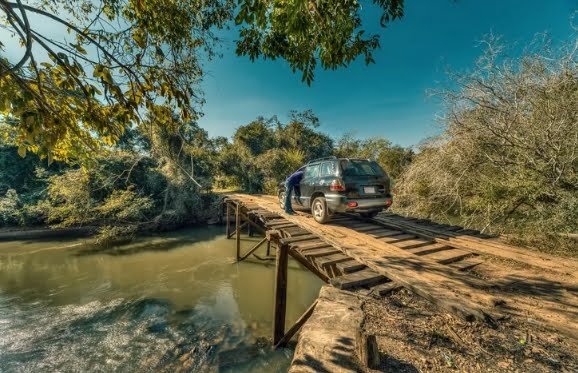To drive in Paraguay, you will need a valid driver’s license from your home country and an international driving permit. While many drivers in Paraguay drive without insurance, it’s a good idea to have at least minimal coverage. Purchase it from your rental agency or use the included insurance on your travel credit card. If you plan to do the latter, check with your credit card company before the trip. Keep a copy of your proof of insurance, along with the registration and a copy of the rental contract, in the car.
You can rent a car if you are over 21. If you are under 25, though, expect to pay a premium.
Checklist for driving in Paraguay
Valid driver’s license (required)
International driving permit (required)
Vehicle registration document (recommended)
Proof of insurance (recommended)
A contract from the rental company (recommended)

Rules of the Road
Stay aware and drive defensively, as many drivers throughout Paraguay ignore traffic regulations. While traffic laws are followed more closely in the larger cities, drivers tend to drive fast and tailgate. In rural areas, drivers (especially truckers familiar with driving these routes) are known for reckless overtaking. As long as you exercise caution, keep your headlights on, and your seat belt fastened, you’ll greatly decrease your chances of having any issues on the road.
Seat belts: Paraguayan law requires all passengers to wear seat belts.
Drinking and driving: The legal blood alcohol limit is 80 milligrams per 100 milliliters of blood
(0.08 percent BAC level).
Headlights: You must keep your headlights on when driving at all times. If they are off, even
during the daytime, the police will pull you over and fine you.
Gas stations: If driving outside of cities, stop to get gas whenever you see a station. In the countryside, gas stations are not abundant, especially along the Trans-Chaco Highway.
Speed limits: Speed limits vary. In urban areas, the limit is 50 kph (31 mph). It is 110 kph (68 mph) in rural areas, and on highways, it is 110 kph (68 mph).
Cellphones: Except for using a hands-free kit, using a cellphone while driving is
illegal; however, this rule is frequently ignored.
Toll roads: The only toll roads in Paraguay are Ruta Nacional 7 and Route PY02 (formerly Ruta Nacional 2). Toll booths only accept cash payment in Guaranis (the local currency).
On-the-spot fines: It is illegal for a police officer to ask for an on-the-spot fine. Payment should be at a police station or a bank within 14 days of a traffic offense. If you do receive a ticket, ask for a paper copy, and pay the fine at a later date to avoid being overcharged. If you are out in the countryside and the fine is not great, you can opt to pay it there (though technically illegal) in the interest of saving time on your journey.
In an emergency: If you need to reach emergency services in Paraguay for any reason, call 911.
Service-specific numbers are 132 for the fire department and 141 for ambulances.
Road Conditions in Paraguay
Of the roughly 37,300 miles of road in Paraguay, 85 percent of roads require a four-wheel-drive vehicle, and only 10 percent are paved. Both urban and rural roads are prone to flooding. National highways are populated with potholes, except for privately managed parts which are tolled. Due to poor road conditions, it’s a good idea to double whatever time your GPS tells you it will take when driving outside of major cities.
Night Driving in Paraguay
If you’re traveling outside of Asuncion, don’t drive at night. In addition to potholes, lack of warning signs about road conditions, and bridges without safety rails, other safety hazards include pedestrians, animals, drunk drivers, and vehicles not using headlights. Additionally, assaults and petty crimes are less likely to occur during the day.
Roadside Assistance
Should you need roadside assistance, call the Touring and Automobile Club. The number for the Asuncion office is 210-550. The club has several branches throughout the country, including in Cuidad del Este, Pozo Colorado, and Encarnacion. Also, be sure to check with your rental company what services or recommendations they can offer, especially if you are going to the Chaco. There are very few towing services outside of cities. Near Asuncion, you can call (021) 224-366, specifically for towing. Even if you can get a towing service in a rural area, don’t expect them to accept cards and have cash ready (especially as some towing services demand payment immediately).
If you are not going to the Chaco, you don’t need to rent a car. Paraguay has a great long-distance bus system between its major cities. Bigger cities like Asuncion and Cuidad del Este have decent
public transportation and rideshares like Uber, making it easy to travel within cities, too. Smaller cities are walkable. Another worthwhile reason to rent a car would be to drive to some of the national parks for easier access to hiking, but even then, it might be easier to take public transportation part of the way and hitchhike the rest. If you do want to go to more remote areas and you really don’t want to drive, check with your hotel in Asuncion about various tourist agencies, like DTP Travel Group, that specialize in trips to the Chaco or national parks and can provide you with transportation.
If you do rent a car, note that most rental cars are stick shifts in Paraguay. If you only drive automatic, book your car well in advance. If you are going into the countryside, rent a four-wheel-drive car. Anything less, and you risk getting stuck on a backroad, especially if it starts raining.
Driving in the Chaco
The Chaco is the harsh, fantastical region that makes up 60 percent of Paraguay, stretching across the northern portion of the country. Filled with giant animals, indigenous groups, and Mennonite communities, it’s difficult to reach and the home of the Trans-Chaco Rally, a motorsport race at the end of September. Driving to it will allow you to experience the Chaco in your own time and interact with the landscape, people, and animals in ways that might be rushed on a tour. If you chose to go, carefully plan your route and check weather forecasts. Roads can be flooded for days after a rainstorm.
Either all or part of your time in the Chaco will be spent on the Trans-Chaco Highway, a 480-mile road stretching from Asuncion to the Bolivian border. Should you want to drive its length, plan for it to take seven to eight days with cautious driving. The road has many deep potholes you will have to weave in and out of not to damage your car. Make stops at each town on the route, as there are few of them, and it’s best to conservatively refuel with gas and food than to be stuck on a stretch of road without provisions.
